I found something in the soundtrack to The Legend of Zelda: Link’s Awakening! It seems like the kind of thing I should have noticed earlier, and maybe it’s not news to you—but maybe it is.
I’m going to assume you’ve played Link’s Awakening, but for the first part of this essay I’m going to act like you never paid much attention to the music. I just want to establish some background regarding the way the game uses leitmotif. If you have a basic understanding of this stuff then you can scroll down to the good part.
If you’ve played Link’s Awakening, you can probably remember two main motifs in its soundtrack. The first is the classic Legend of Zelda theme.
The Legend of Zelda Theme (you can skip this part)
My favorite instance of this theme in this particular game (and also, in any game ever) is the Tal Tal Heights music. I know you remember this, but let’s listen to it now—for fun.
Here’s the part where you hear that theme come in (in the lower staff):

The above score, like all the others I’ll be showing you, is from an arrangement at NinSheetMusic, where folks like Bespinben, V.E. Norman, Seeker, and jake3343 have done the hard work of transcribing/arranging this music for the benefit of lazy people like me. The soundtrack itself (I’m using the files from here) was composed by Kazumi Totaka, Minako Hamano, and Kozue Ishikawa, and I really wish I knew which of them wrote which tunes, but I don’t. Anyway.
The first place you hear the Legend of Zelda theme in Link’s Awakening is immediately, as in right after you turn the game on. Here’s the introductory sequence, which, again, I know you have memorized, but still:
When the game begins, the theme has its rhythm thrown out of joint and a creepy bassline added to express the danger of Link’s situation:
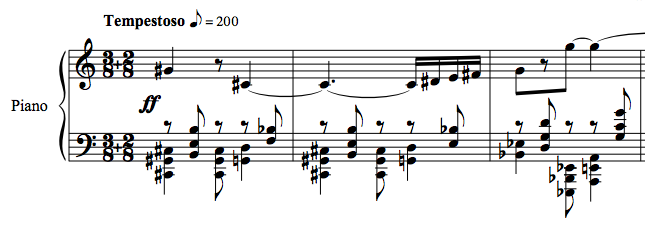
Then there’s an airy, optimistic version of the theme as Marin finds Link washed up on the beach. Then there’s a triumphant 8-bit-orchestral version of the theme as the title of the game appears!
Then there’s yet another version of the theme for the file select screen. Then the game begins, and I’d argue that the music that plays as Link wakes up is a variation on the same theme, and then this version itself gets varied upon in the music that plays while you’re looking for your sword. Then you find the sword, and then triumphant music plays, and then the normal overworld music appears for the first time, and of course this is also a variation on the Legend of Zelda theme.
For the first five minutes of the game, and then for large sections of the rest of the game, you hear the same tune over and over, presented in different ways to match the action. This is a lot like Super Mario World, in which the background tunes for a normal level, an underground level, an “athletic” level, a castle level, and a g h o s t h o u s e are all variations on the same motif. This is also the case to a lesser extent in Super Mario 64, but that won’t be released until 1996. Let’s get back to 1992, and Link’s Awakening.
The other main motif is the Ballad of the Wind Fish.
The Ballad of the Wind Fish (you can also skip this part)
I think the first time you hear part of the Ballad of the Wind Fish is when you find the first Instrument of the Sirens, the Full Moon Cello:
Eventually you hear Marin singing the Ballad of the Wind Fish, and after you get the Ocarina she teaches the song to you.
It’s the most important song in the game, of course, but it doesn’t show up with the unrelenting inevitableness of the Legend of Zelda theme. It doesn’t even play every time you find an Instrument of the Sirens! You only really hear this tune in contexts where you’re actively trying to wake the Wind Fish or you’re interacting with Marin, like when you have a date on the beach:
(You also hear it on the Game Over screen. Whoops!) Really, even though the plot-function of the Ballad is to wake the Wind Fish, it seems like its soundtrack-function, the switch it’s supposed to flip in the player’s brain, is reminding you of Marin. We could almost call it “The Ballad of the Wind Fish (Marin’s Theme).”
So the Totaka/Hamano/Ishikawa team was clearly having fun doing variations on themes. (Have you noticed that Mr. Write’s and Christine’s houses don’t have exactly the same music?) Well, it turns out that one of these themes is pretty subtle. Or, at least, it gets used in some pretty subtle ways. Look: I didn’t notice this until today, so, it can’t be that obvious.
The Compass Motif (this is the cool part)
The theme for normal non-dungeon caves is very similar to the theme for the first dungeon, Tail Cave. Here’s the normal cave music:
And here’s the Tail Cave music:
Ha! Sorry, that was a joke. I switched them around.
Here’s the beginning of Tail Cave. I promise it’s really Tail Cave:
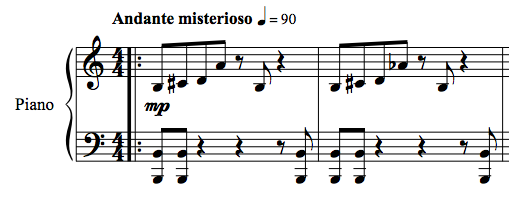
This melody, sparse as it is, appears again in Level 2, Bottle Grotto. It doesn’t show up until about twenty seconds in, though.
At 20 seconds in, it looks like this:
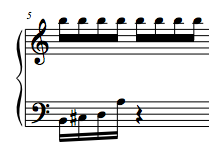
This is what it looks like in the B section, when it gets layered an octave over itself at an appropriately creepy offset:

See if you can hear this motif again in Level 3, Key Cavern:
The bassline sounds very similar—it kinda teases us, then plays the “wrong” fourth note. But then in the B section, we hear the original melody, in a high octave and stretched out metrically:
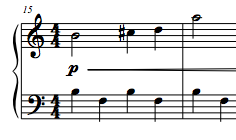
Level 4 is Angler’s Tunnel, and its music is basically the same as the Normal Cave Theme:
But here’s what it looks like, since I couldn’t get you a picture of the Normal Cave Theme’s score:
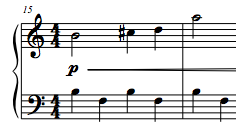
Now, here’s the music for Level 5, Catfish’s Maw:
Only just now, in the middle of writing this essay, have I managed to find the relevant motif in this amelodic doom-music! Around 30 seconds in:
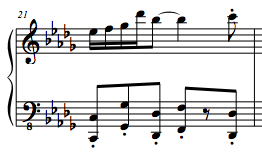
It’s hard to hear those first four notes as the now-familiar motif in this context, but the intervals match up. I understand if this seems like a stretch to you, but stay with me.
SIDE NOTE: I asked my brother, who is better at music theory than I am, what key he thought this track was in, if he thought it was in any key at all. Here’s what he had to say:
The Gb to C repeated hemiola puts it pretty solid in C locrian, or the seventh mode of Db Major, but with color choices like the occasional B naturals (implying harmonic minor) or the secundal note cluster (implying a cat walked on the midi piano).
Let’s skip Level 6 (Face Shrine) for a second and look at Level 7, Eagle’s Tower.
Although I missed it for a long time, the entire B section (starting around 1:30) consists of this motif repeated, in various octaves, transposed and modified a couple of times, over and over again:
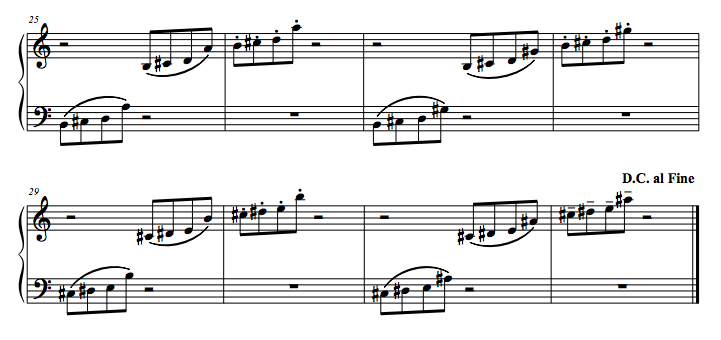
ANYWAY: As far as I can tell, the motif doesn’t appear in the music for Face Shrine or Turtle Rock. But you know what does appear in all those dungeons? Minibosses!
Thrilling! Let’s look at that first thrilling arpeggio:
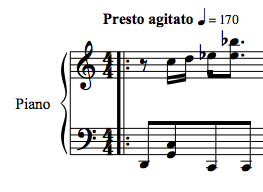
Heck yes! It’s the same motif, played really really fast! It’s also in C minor, whereas in all the dungeons (except the near-atonal Catfish’s Maw) it was in B minor, but the melody is the same. In solfège, it’s rendered: do re me te.
So, you hear this tune in the first four dungeons of the game. You kind of hear it in the fifth. You hear it every time you fight a miniboss, which happens plenty of times, and you hear it every time you go through a normal cave, which happens all the time. But I’ve chosen to call it the “compass motif.”
See, I know you’ve played Link’s Awakening, so you know of course that each dungeon has a compass, which lets you see on the dungeon map where the chests and Nightmare are hidden. But you may have forgotten that the compasses in this game have a new feature—a tone will tell you if a key is hidden in a room when you enter.
That tone is this tone:
Neat!